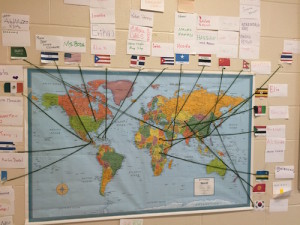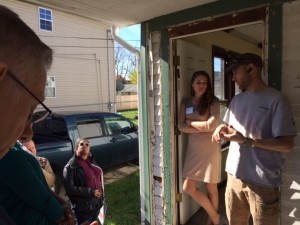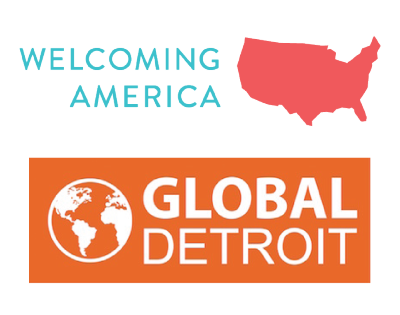Welcoming America’s Guide to Immigrant Economic Development: Workforce Development
 Originally from San Cristobal, Venezuela, Luis Oman arrived in Philadelphia in January of 2015 in “pursuit of a bright future and a good life.” The high inflation in Venezuela made life difficult for Luis. He could barely get by with a minimum wage job, even after graduating from one of the best -and oldest- universities in Venezuela, with a degree as a chemical engineer and a concentration in petroleum studies.
Originally from San Cristobal, Venezuela, Luis Oman arrived in Philadelphia in January of 2015 in “pursuit of a bright future and a good life.” The high inflation in Venezuela made life difficult for Luis. He could barely get by with a minimum wage job, even after graduating from one of the best -and oldest- universities in Venezuela, with a degree as a chemical engineer and a concentration in petroleum studies.
Luis’ original intention for coming to the Welcoming Center was to enroll in English language courses, but he has since been able to take advantage of the Welcoming Center’s job placement services to land an initial job with his limited, although rapidly improving, English.
After a couple of months in English classes, Luis needed to find employment and began working with one of the Welcoming Center’s Employment Specialists. He received help writing his resume, filling out job applications, and preparing for interviews. Welcoming Center staff took Luis to multiple interviews and were in touch with him during the entire job search process, letting him know when there was an update with the status of his applications.
Finally, Luis was offered a job on the afternoon shift as a bulk folder at Cintas, a large company that emphasizes customer service. His department is in charge of packaging the products that will be sent back to hospitals and hotels.
While he is thrilled to be working in the U.S., Luis hopes to someday get a job in his field of chemical engineering. In order to help meet his goal of professional-level employment, he has since enrolled in another complementary program at the Welcoming Center to help college-degreed immigrants re-license in the U.S. or attain meaningful employment in their field.
Luis plans to stay in Philadelphia for the time being and continues his work at Cintas, while also working to improve his English. He has even found a speaking partner that he meets every week.
Why Local Economic Development should Consider Immigrant Labor
The U.S. population is getting older as baby boomers enter retirement and the nation’s birth rates are at an all-time low. Furthermore, as U.S.-born workers become more educated – only 7.4 percent of U.S.-born Americans are without a high school diploma – the demand for entry-level jobs must be met. Immigrant labor is aptly suited to fill this need: roughly 80 percent of the 1 million immigrants who enter the U.S. annually are “working age” (classified as ages 18 to 64) compared to only 60 percent of the U.S.-born population. As a result of these trends, immigrant workers now account for 49 percent of all workers in the U.S. workforce without a high-school degree. The demand for lower-skilled labor has and will continue to be met by immigrant workers, an increasingly important and critical part of the U.S. and regional labors.
Assisting working-class immigrants to integrate into the U.S. and regional workforce is a cost effective policy solution compared to the anticipated costs of having those same individuals not participate in the workforce or working in the informal economy—losing the opportunity to build financial history or fully pay taxes. Local economies that put workers’ skills and knowledge to their highest use and that can best integrate the labor pool of working-class immigrants will have competitive advantages over other regions.
Workforce Development Model Programs
The field of workforce development for working-class immigrants and refugees is vast. Comprehensive workforce development programs, provide a wide array of solutions to break down the various barriers to employment through services such as job coaching, advising, and readiness, English classes, financial literacy, and support services (childcare, transportation, asset building, etc.). The Welcoming Center for New Pennsylvanians provides one example. The Welcoming Center began as a centralized resource and employment center for immigrants in Philadelphia. Since its inception, the Welcoming Center has served over 10,000 immigrants from 140 countries worldwide. Because immigrants have comprised nearly 75 percent of the growth in the Philadelphia region’s workforce from 2000 to 2010, the Welcoming Center has been an integral component of the region’s workforce development infrastructure. The Welcoming Center’s programs and practices have produced remarkable results, including higher retention and placement rates for its foreign-born clients, surpassing those of other regional workforce development programs working with the mainstream population.
Industry-specific workforce development programs take advantage of developing industry-specific English language training, connecting with a targeted set of employers for job placement, focusing on a limited number of needed job skills, and developing strategic pathways to help immigrants establish and advance careers within the industry. Restaurant Opportunities Centers (ROC) United works to improve wages and working conditions for the nation’s restaurant workforce. It is a member-based organization operating in 12 cities with 13,000 restaurant workers, 100 employers, and thousands of engaged consumers united for raising restaurant industry standards. While ROC is not limited to serving immigrants specifically, the majority of its members are immigrants and people of color. Foreign-born workers (7.7 percent) are 40 percent more likely than native-born workers (5.3 percent) to be employed in food preparation and service occupations. For many immigrants and refugees, the food service industry is a gateway to the American economy and stepping-stone to achieving the American Dream.
Vocational and workforce English language programs are focused on providing “survival skills” and helping immigrants and refugees achieve conversation fluency in their work environment, just one of the many specific skills they will need to succeed in the workplace. These programs are tailored to serve a sweeping range of participants, including both those seeking to enter the workforce and non-workers for whom
immediate survival, basic English, or the ability simply to talk to a family member’s doctors or teachers are their more pressing priorities. English for New Bostonians (ENB), a public-private-community collaboration, was launched to address the urgent need for increased English language learning opportunities for adult immigrants in Boston. ENB develops new strategies to reach more learners at home, at work, and in the community and reaches 1,200 immigrants annually.
Where to Learn More
Welcoming America’s Guide to Immigrant Economic Development contains a chapter that chronicles the economic opportunities that working-class immigrants can create, as well as eleven other strategies employed by local immigrant economic development initiatives across the country. It is the first guide to ever detail the economic development opportunities and strategies for local economic development leaders, public policymakers, chambers of commerce, immigration advocates, nonprofit organizations, philanthropic leaders, and others who want to build a more prosperous and inclusive economy by welcoming immigrants. You can download your free copy of the guide here.
Thanks to the Welcoming Center for New Pennsylvanians for contributing Luis’ story.





